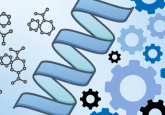Using peptides for accelerated detection of herpes virus

Scientists from University College Dublin (Ireland) have developed a new assay to identify the herpes simplex virus-1 (HSV-1). The research, recently published in Analyst, details the new test that is faster and more cost effective than existing methods.
This assay was observed to be superior to other available tests, which can be time consuming and often require specialist personnel to complete. The most viable existing HSV-1 test can take up to a week to complete and involves the use of cell cultures.
While typical symptoms of the virus are sores or blisters, it can infect the central nervous system, which if untreated is fatal in 70% of cases. Early diagnosis and application of antiviral therapy can prevent this; highlighting the need for faster diagnostic methods.
This novel assay utilizes beads comprised of peptide-coated iron oxide nanoparticles that bind to the virus. Aggregation can be accelerated with the use of a magnet as the nanoparticles are superparamagnetic; a flow cytometer is used to identify the aggregations. Light scattered by the bead–virus complex is then used to indicate the presence of the infection. “We knew that a magnetic bead assay had the potential to be very sensitive based on our previous work,“ explained researcher Gil Lee (University College Dublin).
According to Lee, “HSV is among the most difficult viruses to detect with this technique because it is a relatively large virus and has a complex and irregular membrane coat.” However peptides, coating the nanoparticles, are able to overcome the structural complexity of the virus for which it has previously been hard to identify ligands.
The key to this method’s success is the peptide receptors. These beads can directly aggregate to the virus making it less expensive, and more convenient and sensitive. The sensitivity of this method is increased to 200 copies per ml of sample and takes minutes to complete.
Many existing diagnostic tests require antibody recognition, however for this to work patients have to have previously had an immune response to the virus.
Ruben Carbonell of North Carolina State University (NC, USA) commented: “It is interesting that since the assay methodology is rapid and label-free, it may be suitable for point-of-care applications in hospitals or doctors’ offices.”
Going forward the team is hopeful their assay can be used to improve point-of-care treatment of HSV and as a start point to extend the research to other viral diseases such as HIV. Reducing the cost should make these diagnostic methods more available to developing countries. “While there is still a lot of work to be done to establish this technique as a validated analytical procedure, its advantages hold a great deal of promise for wider application,” explained Carbonell.
Sources: New test accelerates herpes detection; Ran Y, Fields C, Muzard J, et al. Rapid, highly sensitive detection of herpes simplex virus-1 using multiple antigenic peptide-coated superparamagnetic beads. Analyst. 139(23), 6126–6134 (2014).





